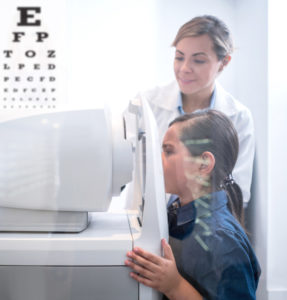sponsored content
August 16, 2021
By Noel A. Brennan, MScOptom, PhD, FAAO
Why haven’t we seen an increase in myopia-related pathology in the United States to date? The answer is quite simple; it is all about timelines.

A common statement from United States practitioners who are hesitant to adopt myopia control is that they are not seeing an increase of myopia-related pathology in their practice. Natural conclusions from this observation are that they believe the threat of myopia to have been largely overstated and that treatments to delay onset and slow progression of myopia are unnecessary. Well, these practitioners are largely correct about the incidence of myopia-related pathology, particularly in practices in the Western world — it has not risen very much to date. That said, the best current evidence shows that an attitude of complacency around the looming threat that myopia poses is seriously misplaced.
So, why haven’t we seen an increase in myopia-related pathology in the United States to date? The answer is quite simple; it is all about timelines. The first robust evidence of a myopia epidemic emerged in the 1980s in Taiwan, Singapore, and Hong Kong.1,2 Reports of rising prevalence in China and South Korea appeared even later. In the United States, overall myopia prevalence among 12- to 54-year-olds was around 25% in the early 1970s and was fairly even across ages.3 This rate was not highlighted as a cause for concern. By the turn of the century, using a similar methodology, this prevalence was estimated to be 42%, reflecting an elevated incidence in younger generations.3 By and large then, “children of the epidemic” were born after 1970. Pathology associated with myopia rarely occurs before 50 years of age, and onset is principally found in people in their 60s and 70s. Thus, the disease burden from the myopia epidemic is yet to manifest in a big way — but it is certainly coming.
One exception to the myopia prevalence timelines presented above gives insight into what might be expected elsewhere in the world in coming years. Myopia prevalence in Japan in the last century shows somewhat remarkable parallels to sociopolitical events of the time. There is evidence of raised myopia prevalence prior to World War II in keeping with the heavy industrialization in the country at the time. A notable dip in prevalence occurred among those born just before or during the war, followed by a constant but inexorable increase since then.1,2 As early as 1968, pathologic myopia was described as the leading cause of vision impairment in Japan.4 Given the extended timeline of raised myopia prevalence, Japan is not surprisingly home to some of the world’s leading experts in myopia-related pathology. And just recently, a longitudinal population-based study provides marvelous insights into what may await the Western world. Ueda et al. observed a significant but relatively modest increase in myopia prevalence from 38% to 46% in a population-based study of residents over 40 years of age between 2005 and 2017.5 This is consistent with the generational advance of myopia. The prevalence of high myopia (<-5.0D) showed a greater proportional increase from 5.8% to 9.5%. Most importantly, the prevalence of myopic maculopathy more than doubled from 1.6% to 3.6% over this 12-year period. The disproportionate increase in disease prevalence compared to that for overall myopia prevalence is not unexpected and is a warning to the Western world. For example, Brien Holden Vision Institute predicts a 3.4 times increase in the population of myopes in the world from the year 2000 to 2050 but a 13.3 times increase in the number of visually impaired as a result of myopic macular degeneration.6,7
What Does the Future Look Like?
So what is the outlook with regard to the impact of myopia on global visual health? The projections are stark. Already, pathologic myopia is the leading cause of irreversible blindness in Taiwan, Japan, and China.8 Fricke et al. have projected that the number of vision impaired due to myopia macular degeneration will increase by over 13 times between the years 2000 and 2050.7 Tideman et al. predict that over 10% of people in the most affected areas, major urban centers in East Asia and Singapore, will suffer from myopia-related vision impairment.9 Our own analysis projects that myopia will be the leading cause of irreversible vision impairment in the United States by 2050, with over 30% of all visual impairment being solely attributable to myopia.10 In light of the available evidence, various professional bodies around the world are prioritizing myopia for action. For example, the American Academy of Ophthalmology’s Board of Trustees affirms that “myopia is a high-priority cause of visual impairment.”11 Its Task Force on Myopia states clearly that the projected international growth in myopia prevalence and its secondary complications are “cause for alarm.”11
Perhaps the most sobering statistics to consider, though, are shown in Table 1. In the Western world, there is a tendency to think of myopia as being a problem isolated to East Asia and Singapore. Initiatives with government support in China, Taiwan, and Singapore reflect the level of concern in these regions.12-14 Table 1 provides estimates of myopia prevalence from the much cited paper of Holden et al. for East Asia in 2020 and North America in 2050.6 The projected prevalence of myopia in 2050 for North America is higher than currently estimated for East Asia. The implication of this data is that, no matter how bad the myopia situation is among the most impacted countries in Asia right now, it is projected to be worse in the United States in 2050.
Table 1: Myopia and High Myopia Prevalence Estimates from Holden et al. for East Asia in 2020 and North America in 2050.
|
2020 East Asia |
2050 North America | |
| Myopia | 51.6% | 58.4% |
| High Myopia | 13.8% | 14.7% |
All Myopes Are at Risk
For the many people who are already highly myopic, the risk of vision-threatening complications is already present unless cures for myopia-related complications are found where none currently exist. But myopes of lower degree are also at risk; there is no safe level of myopia.15 As simple examples, the U.S.-based Eye Disease Case-Control Study Group found that myopes of -1.00D to -3.00D carry four times the risk of idiopathic retinal detachment compared with emmetropes,16 and the large-scale population-based Singapore Epidemiology of Eye Disease study observed that over 40% of all cases of myopic macular degeneration were myopes of -0.50D to -3.00D.17 While the overall incidence of vision impairment is modest at these low levels of myopia, the large and increasing population of myopes means that “the population-based burden of lower degrees of myopia remains considerable.”11
To stop myopia becoming the great threat to visual well-being of the United States population that it is for East Asians, a change in mindset of practitioners is required. To this end, all children 12 years of age and under should be treated to slow myopia progression, as should teenagers with moderate degrees of myopia.18,19

Noel A. Brennan, MScOptom, PhD, FAAO, is Clinical Research Fellow, Myopia Control Platform, Johnson & Johnson Vision. This article is sponsored by Johnson & Johnson Vision.
References
- Ding BY, Shih YF, Lin LLK, et al. Myopia among Schoolchildren in East Asia and Singapore. Surv Ophthalmol 2017;62:677-97.
- Morgan IG, French AN, Ashby RS, et al. The Epidemics of Myopia: Aetiology and Prevention. Prog Retin Eye Res 2018;62:134-49.
- Vitale S, Sperduto RD, Ferris FL, 3rd. Increased Prevalence of Myopia in the United States between 1971-1972 and 1999-2004. Arch Ophthalmol 2009;127:1632-9.
- Tokoro T. On the Definition of Pathologic Myopia in Group Studies. Acta Ophthalmol Suppl 1988;185:107-8.
- Ueda E, Yasuda M, Fujiwara K, et al. Trends in the Prevalence of Myopia and Myopic Maculopathy in a Japanese Population: The Hisayama Study. Invest Ophthalmol Vis Sci 2019;60:2781-6.
- Holden BA, Fricke TR, Wilson DA, et al. Global Prevalence of Myopia and High Myopia and Temporal Trends from 2000 through 2050. Ophthalmol 2016;123:1036-42.
- Fricke TR, Jong M, Naidoo KS, et al. Global Prevalence of Visual Impairment Associated with Myopic Macular Degeneration and Temporal Trends from 2000 through 2050: Systematic Review, Meta-Analysis and Modelling. Br J Ophthalmol 2018;102:855-62.
- Ohno-Matsui K, Wu PC, Yamashiro K, et al. IMI Pathologic Myopia. Invest Ophthalmol Vis Sci 2021;62:5.
- Tideman JW, Snabel MC, Tedja MS, et al. Association of Axial Length with Risk of Uncorrectable Visual Impairment for Europeans with Myopia. JAMA Ophthalmol 2016;134:1355-63.
- Bullimore MA, Brennan NA. The Underestimated Role of Myopia in Projected Visual Impairment in the United States. Investigative Ophthalmology & Visual Science 2021;62:2325-.
- Modjtahedi BS, Abbott RL, Fong DS, et al. Reducing the Global Burden of Myopia by Delaying the Onset of Myopia and Reducing Myopic Progression in Children: The Academy’s Task Force on Myopia. Ophthalmology 2021;128:816-26.
- Jan C, Li L, Keay L, et al. Prevention of Myopia, China. Bulletin of the World Health Organization 2020;98:435.
- Wu PC, Chen CT, Chang LC, et al. Increased Time Outdoors Is Followed by Reversal of the Long-Term Trend to Reduced Visual Acuity in Taiwan Primary School Students. Ophthalmology 2020;127:1462-9.
- Ngo CS, Pan CW, Finkelstein EA, et al. A Cluster Randomised Controlled Trial Evaluating an Incentive‐Based Outdoor Physical Activity Programme to Increase Outdoor Time and Prevent Myopia in Children. Ophthalmic and Physiological Optics 2014;34:362-8.
- Flitcroft DI. The Complex Interactions of Retinal, Optical and Environmental Factors in Myopia Aetiology. Prog Retin Eye Res 2012;31:622-60.
- Eye Disease Case Control Study Group. Risk Factors for Idiopathic Rhegmatogenous Retinal Detachment. Am J Epidemiol 1993;137:749-57.
- Wong YL, Sabanayagam C, Ding Y, et al. Prevalence, Risk Factors, and Impact of Myopic Macular Degeneration on Visual Impairment and Functioning Among Adults in Singapore. Invest Ophthalmol Vis Sci. 2018;59:4603-4613.
- Bullimore MA, Richdale K. Myopia Control 2020: Where are we and where are we heading? Ophthalmic Physiol Opt. 2020;40:254-270.
- Brennan N. Why every myopic child needs to be treated. Review of Myopia Management. November 16, 2020. https://reviewofmm.com/why-every-myopic-child-needs-to-be-treated/













